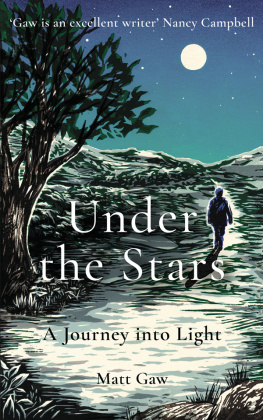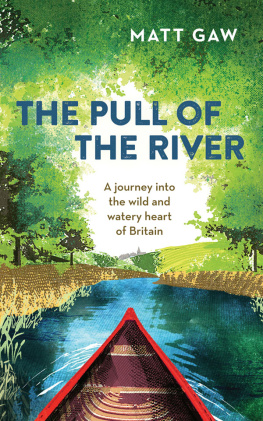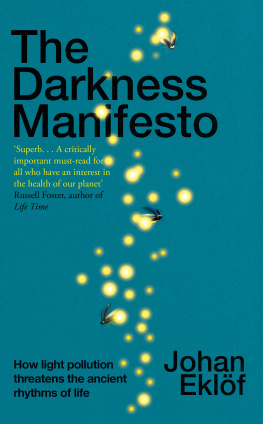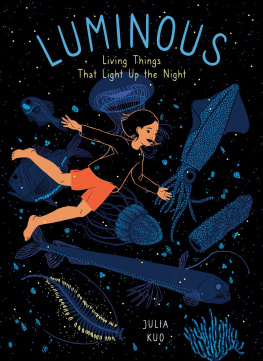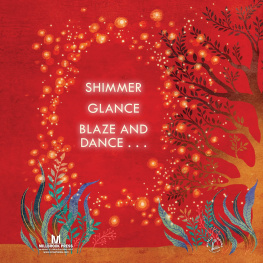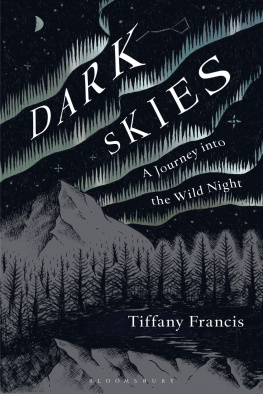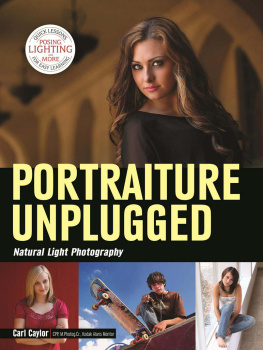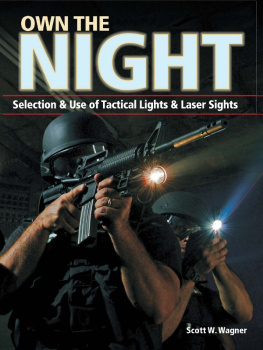Contents
Guide


For Jen, Eliza and Seth,
and anyone who wanders or works in the night
Contents
Introduction
T he snow clouds mean there is no visible sunset tonight. The sky does not burn and bruise; the hot yolk of the sun does not split and run across the horizon in gold, yellow and peach. The cold, white sky does not even blush.
Instead, the light thickens and clots as darkness begins to form. It seeps and smokes from between stands of pines planted an arms-length apart. It rises from the shadows of my footsteps on the track, and wells up from the deep, frozen ruts made by 44s and forestry machinery that trundle through this plantation.
For more than an hour now I have tramped through the forest that grows a few miles from my home, its familiar ruler-straight rides sparkling with fresh spring snow that still falls in fat, bumblebee flakes. The trees drooping, smoored and smothered.
Now the world is about to transform again. Night is coming. Darkness will soon cover the forest as surely as any snow.
I cant remember the last time I was out at night. Not just out, camping, running or toddling home from pubs, but really out; walking and watching as the light fades, experiencing darkness creeping up with each passing minute, from mountain to meadow.
It was my ten-year-old son who had inspired this impromptu outing. The other day, as he argued for a later bedtime, he told me solemnly that the average human will spend twenty-six years of life asleep. Although he was still ushered complaining to his room, his words wormed their way into my brain. They made me realise that my experience of night was one of eyes moving sightlessly against lowered lids rather than a view of the changing shades of the nocturnal hours. Although he might not have meant it as such, it was also a rebuke; a reminder that for all of my lifes apparent fullness, it was in fact being only half lived. And so, here I am. Venturing into the darkness.
Even though Ive been waiting for it, almost willing the night to arrive, the physicality of twilight surprises me. Catches me off guard. The air itself is a tangible mesh. A veil or a threshold to be crossed; from daylight to nightlight. The shifts might be gradual, but they are also dizzying. The light fuzzes like the picture on an old TV set. All feels hazy, flickering and granular.
At first I trip with every other step, until my eyes begin to adjust to the lowering light. My hearing seems sharper too; more eager to pick up any rustle or snow-muffled fidget.
Slowly, slowly, the definition of day blurs. I can no longer see the falling snow, although I can feel it on my face. The trees web together, the colours and contrasts grey into graphite. A detailed landscape rewinds to a simple but exquisite pencil sketch. The horizon becomes smudged as earth fuses with heavens.
By the time I reach the northern edge of the forest it is gone 11 p.m. and its as dark as its going to get. With the moon new and the cloud smoking-room thick, the only source of light seems to be the snow itself; the smashed-glass sparkle of twilight replaced by a watery luminescence that creates a topsy-turvy world where the land is brighter than the sky. Only under the trees, where the snow did not reach, has light been fully lost.
Out of the forest, the sky is a thick cobweb-grey that clings to heath and field, bunching in lighter, wet swags around wind-sharpened drifts of snow and darkening around ink-blot patches of gorse and bramble. Fallow deer, disturbed by the sound of my slow, snow-crumping footsteps, break into a fat-bottomed, see-sawing run. Others follow, the call to movement simply impossible to resist, until the whole herd pours over the path in front of me. They move as one, a liquid form that jumps, jinks and springs away from open land towards the trees to my right. I watch as they go, their black shapes lit by snowlight and their own flashing scuts. Every muffled hoof-strike reverberating deep in my chest.
Ive seen deer on the move before, plenty of times, but during the day. Theres something about the night-time world that made the experience feel more intense, my world reduced by darkness to a much more intimate one that we briefly inhabited together.
Ive never really considered exploring the night-scape before. To me night has always been a dark and gloomy place. A solid, black bookend to day that inspires fear and anxiety. But here among the trees, cloud and snowglow, I can already see that night is not just one long stretch of unforgiving darkness, any more than daytime is constant bright blue sky. Night is full of its own subtle shades of light, capable of illuminating the landscape and inspiring in us a sense of connection and wonder. I feel a tingle of delight at the realisation that almost by accident Ive ghosted into a different world.

I wake late to the shouts of my children outside in the snow, enjoying their gift from the night. My legs feel stiff, and the balls of my feet sore from the walk. A cup of tea, lukewarm, sits on the bedside table. The curtains have been opened and the sky is heavy. More snow is on the way. The cat pushes through the half-closed door and jumps onto the bed. A night-seeker and snow-hater. He rubs his cheeks hard against my duvet-swaddled ankles and curls into a purring ball. Paws lifted, chin raised. I fuss him and think about the woods. The snow. The deer. The shades of the night.
Certainly, the way the night was lit up has stayed with me. I wonder how it would have appeared without the clouds; how the soft slide from day to night would have been different; how starlight, glinting hard off snow, would have expanded the night beyond a tree-lined horizon. But the clouds were also part of the magic, obstructing the glow from towns: the streetlights of Bury St Edmunds to the south and of Thetford to the north.
On our relatively small but densely populated island, there are up to 9 million streetlamps (one for every eight people). Their glare, when combined with that of 27 million homes, offices, warehouses and factories, is scattered by atmospheric particles to create a sickly orange skyglow capable of blotting out the nocturnal interplay of natural light the ever-present glare of electricity chases away darkness and snuffs out the stars.
That is surely one of the reasons I, like so many others, have been guilty of ignoring the night. Its something that many of us rarely experience at length. For aeons humans have tried to push the night away. As the sun lowers we go inside, lock our doors and draw our curtains. We turn on our lights. Fire, the putrid luminescence of rotting fish, the burning bodies of oily seabirds, fireflies gummed to toes, yellow, fatty candles, gas lights and then electricity all have been used to conquer and vanquish the hours of darkness, transforming them into a duller kind of day.
But after finally getting a glimpse of natural darkness, I want to explore more. I want to immerse myself in all the different types of light and dark that night has to offer: to feel moonlight on my skin, to see a hard frost of stars across a dark sky, and to understand what effect the ever increasing blaze of artificial light has on our natural rhythms, and those of other species. And I want to experience again how the changing, thickening light has the power to transform our world.

